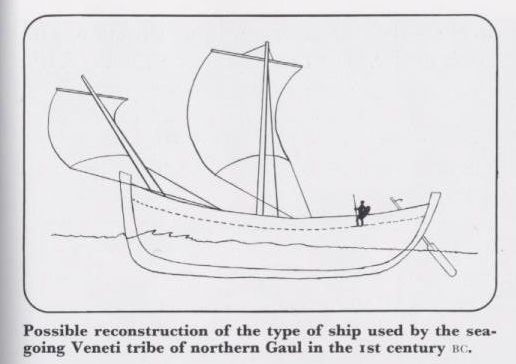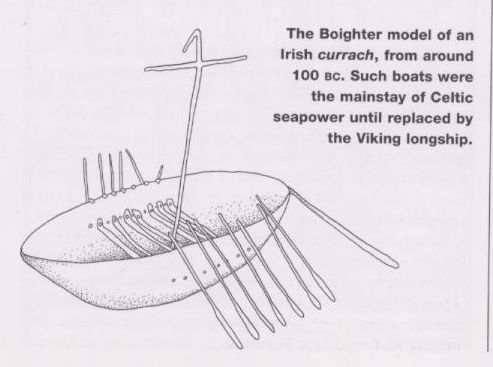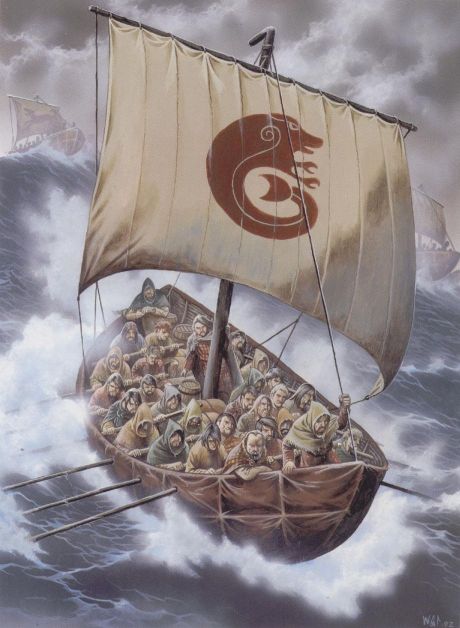I figger I ought to continue this in it's own thread, as it has little to do with that awesome Phonecian Bireme aaglo did...

--Credit: Rome's Enemies (2): Gallic & British Celts (Oxford: Osprey, 1985), p. 39.
This sucker ain't a skin hemisphere! If its oak construction was impervious to Roman rams, if its sides were too high for the corvus to get a hold on (and if "Unlike the Roman galleys which were uncomfortable in the waters of the North Atlantic the ships of the Veneti were capable sailers"), I figger it warrants a place in Civ far more prestigious than Conquests' "It is a tiny, primitive boat that must end each turn in a coastal square -- they are in danger of sinking if they end their turn in a sea or ocean square." That is, a great big wooden beast of a ship would be more in order than the stock graphic we've got at present. We need a ship bigger than a galley!
If its oak construction was impervious to Roman rams, if its sides were too high for the corvus to get a hold on (and if "Unlike the Roman galleys which were uncomfortable in the waters of the North Atlantic the ships of the Veneti were capable sailers"), I figger it warrants a place in Civ far more prestigious than Conquests' "It is a tiny, primitive boat that must end each turn in a coastal square -- they are in danger of sinking if they end their turn in a sea or ocean square." That is, a great big wooden beast of a ship would be more in order than the stock graphic we've got at present. We need a ship bigger than a galley!  (Oh yeah, and it doesn't have oars...which is a big reason why it lost to the Romans, on a nice calm day!)
(Oh yeah, and it doesn't have oars...which is a big reason why it lost to the Romans, on a nice calm day!)
(Okay, honestly, I really don't know what I'm talking about. I ain't no historian, eh...)
This Irish model below might be more of a skin-type boat (I can't really tell), but still a far cry from one of them little hemispherical bathtubs:

--Credit: Pictish Warrior AD 297-841 (Oxford: Osprey, 2002), p. 61.
The following Pictish boat is obviously skin-covered, but still pretty intense looking. Sweet logo on the sail...

--Credit: Pictish Warrior AD 297-841,illustrated by Wayne Reynolds (Oxford: Osprey, 2002), p. 35 (plate C).
Quite frankly, I dunno what the C3C Curragh graphic is good for at all! If they wanted something to double as "a small boat made of skin stretched over a frame of wood" that could "represent any small boat (papyrus, wooden canoes or rafts, etc.) used by ancient people to expedite movement up and down waterways and along coastal shorelines," they should have called it a coracle, and done-up a graphic of a semi-spherical one-man kiddie-pool like the one St. Patrick was supposed to have crossed over to Ireland in, or like Reepicheep used to sail over the edge of the world at the end of the Voyage of the Dawntreader.
Okay, I gotta stop :rant:-ing!
If anyone has any better pictures of curraghs, do post 'em. If anyone has a better case as to why we need a cooler curragh graphic, do tell. If anyone thinks we ought not to have such a unit, fire away! I wouldn't want to have a unit creator start making this boat without a decent case backing it up...
Gogf said:Time to replace the curragh...
Mithadan said:Speaking of the curragh, that graphic sucks! There needs to be a way better graphic for the curragh, that wicked huge hulk of a Celtic ship.
Well, I got me to a scanner today. Further to this helpful text, here are the only pictures I've got:aaglo said:Curragh: Do you mean that silly looking half of a sphere?- or a rowing boat? What does a curragh look like?

--Credit: Rome's Enemies (2): Gallic & British Celts (Oxford: Osprey, 1985), p. 39.
This sucker ain't a skin hemisphere!
 If its oak construction was impervious to Roman rams, if its sides were too high for the corvus to get a hold on (and if "Unlike the Roman galleys which were uncomfortable in the waters of the North Atlantic the ships of the Veneti were capable sailers"), I figger it warrants a place in Civ far more prestigious than Conquests' "It is a tiny, primitive boat that must end each turn in a coastal square -- they are in danger of sinking if they end their turn in a sea or ocean square." That is, a great big wooden beast of a ship would be more in order than the stock graphic we've got at present. We need a ship bigger than a galley!
If its oak construction was impervious to Roman rams, if its sides were too high for the corvus to get a hold on (and if "Unlike the Roman galleys which were uncomfortable in the waters of the North Atlantic the ships of the Veneti were capable sailers"), I figger it warrants a place in Civ far more prestigious than Conquests' "It is a tiny, primitive boat that must end each turn in a coastal square -- they are in danger of sinking if they end their turn in a sea or ocean square." That is, a great big wooden beast of a ship would be more in order than the stock graphic we've got at present. We need a ship bigger than a galley!  (Oh yeah, and it doesn't have oars...which is a big reason why it lost to the Romans, on a nice calm day!)
(Oh yeah, and it doesn't have oars...which is a big reason why it lost to the Romans, on a nice calm day!)(Okay, honestly, I really don't know what I'm talking about. I ain't no historian, eh...)
This Irish model below might be more of a skin-type boat (I can't really tell), but still a far cry from one of them little hemispherical bathtubs:

--Credit: Pictish Warrior AD 297-841 (Oxford: Osprey, 2002), p. 61.
The following Pictish boat is obviously skin-covered, but still pretty intense looking. Sweet logo on the sail...

--Credit: Pictish Warrior AD 297-841,illustrated by Wayne Reynolds (Oxford: Osprey, 2002), p. 35 (plate C).
Quite frankly, I dunno what the C3C Curragh graphic is good for at all! If they wanted something to double as "a small boat made of skin stretched over a frame of wood" that could "represent any small boat (papyrus, wooden canoes or rafts, etc.) used by ancient people to expedite movement up and down waterways and along coastal shorelines," they should have called it a coracle, and done-up a graphic of a semi-spherical one-man kiddie-pool like the one St. Patrick was supposed to have crossed over to Ireland in, or like Reepicheep used to sail over the edge of the world at the end of the Voyage of the Dawntreader.

Okay, I gotta stop :rant:-ing!
If anyone has any better pictures of curraghs, do post 'em. If anyone has a better case as to why we need a cooler curragh graphic, do tell. If anyone thinks we ought not to have such a unit, fire away! I wouldn't want to have a unit creator start making this boat without a decent case backing it up...


